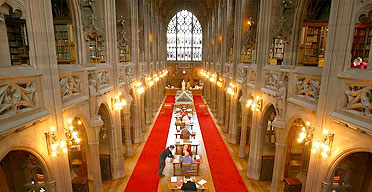
Water is leaking through the flat roof above the ornate stone carvings and a small pile of plaster has fallen on to a stairwell as one of Britain's most remarkable libraries prepares to close for a £15m refurbishment which will take around two years to complete.
The John Rylands Library in Manchester is a neo-gothic cathedral of learning and a tranquil retreat on one of the city's main roads. In the reading room, large stained glass windows feature luminaries of theology, philosophy, literature and art, while 20 statues watch over the readers beneath.
The grade I listed building is in urgent need of refurbishment - its flat iron roof has been leaking since it was opened on January 1 1900 - and the work will make it more accessible and popular.
A modern extension will be added to the side of the building, with a pitched roof, glass atrium, cafe, reception area and bookshop. A lift will take visitors to the reading room - currently only accessible by winding stone steps.
Many of the library's treasures, which are not on public display, will be properly exhibited for the first time. The St John Fragment, the oldest piece of the New Testament in existence, will be among them.
The building is named after the wealthy Manchester cotton merchant and philanthropist John Rylands who died in 1888 leaving a £2.75m fortune. His widow Enriqueta commissioned the blushing pink sandstone building (which has become ingrained with dirt over the years). It took 10 years to build.
The library contains 1m manuscripts and books. It regularly holds exhibitions of its treasures, which include a Caxton Chaucer of 1476, believed to be the first book to be printed in England. It also houses the papers of John and Charles Wesley.
Its collection is vast and varied and includes a Latin manuscript from the 10th century, a medical collection of plastic surgery from 1597 and the Grafton portrait - by an anonymous artist - which is believed to be of William Shakespeare. The portrait is currently on the wall of a wood-panelled meeting room which is not open to the public.
While the refurbishment is taking place, the collection will be housed in a cavernous salt mine in Winsford, Cheshire. It will take a team of librarians and removal specialists around three months to move the exhibitions to their temporary home.
Alison Firth, development manager for the appeal for funds to pay for the work, said the major problem was the leaking roof. But she added: "There will be more exhibition space and interactive exhibits. It will be accessible to wheelchair users for the first time."
The appeal was launched in January by the Duke of Devonshire. The heritage lottery fund has offered £8.2m and £3m has come from the European regional development fund. But fundraisers need to find £4m.
It is hoped that visitor numbers, currently a modest 30,000 a year, will triple. The library closes for the work on August 29.

